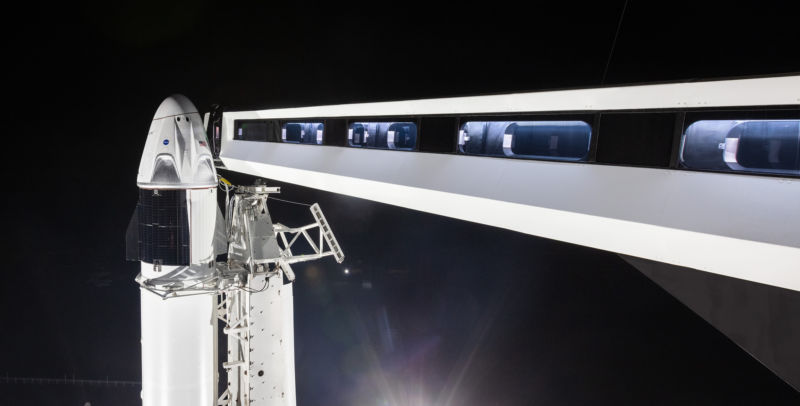
During a news conference Thursday in advance of a SpaceX supply mission to the International Space Station, the company's vice president of mission assurance, Hans Koenigsmann, provided some additional details about a failure with the company's Crew Dragon spacecraft 12 days ago.
In the company's most expansive comments to date, Koenigsmann said the "anomaly" occurred during a series of tests with the spacecraft, approximately one-half second before the firing of the SuperDraco thrusters. At that point, he said, "There was an anomaly and the vehicle was destroyed."
During the activation phase, the SuperDraco thruster system is pressurized, and valves are opened and closed. Since the accident there has been speculation that there may have been some issue with the composite overwrap pressure vessels, or COPVs, which store rocket fuels at extremely high pressures. The COPVs on Crew Dragon are different from those on the Falcon 9, and they would not have been overly stressed at that moment, Koenigsmann said. "I'm fairly confident that the COPVs are going to be fine," he said.
Investigative teams from SpaceX and NASA are carefully reviewing telemetry data and high-speed imagery, Koenigsmann said, and soon they will begin analyzing pieces of the spacecraft recovered at the test site near Kennedy Space Center in Florida. Because this was a ground test, there is ample data for engineers to consider. He admitted the failure did come as "a shock" to some of the company's engineers.
It is too early to determine a probable, or root, cause, but Koenigsmann expressed confidence in the SuperDraco thruster system. He noted that SpaceX has tested these powerful thrusters more than 600 times at its test facilities in McGregor, Texas. Moreover, they have performed well in hover tests as well as a launch pad abort test in 2015. "We have no reason to believe there’s an issue with the SuperDracos themselves," he said.
SuperDracos
SpaceX has been developing SuperDraco thrusters for the better part of a decade to enable human flights on board Dragon. There are four "pods" of two engines each situated around the Crew Dragon capsule, and each SuperDraco engine has a thrust of 16,000 pounds. Testing of the SuperDracos began in early 2012 using various thrust cycles on a test stand at SpaceX's rocket development facility in McGregor.
The lost spacecraft is the same one that successfully flew a demonstration mission to the International Space Station in March. (During that Demo-1 mission, the SuperDracos were not activated.) After the March flight, the Dragon spacecraft was being prepared for a launch abort test this summer.
During this launch abort test, the Dragon would have launched from Florida on a Falcon 9 booster and then fired its powerful SuperDraco engines to show that the Dragon could pull itself safely away from the rocket in case of a problem with the booster before or during flight. It is not clear what vehicle SpaceX will now use for that launch abort test, which will be all the more scrutinized due to the accident on April 20.
-
Four pairs of SuperDraco engines power the Crew Dragon spacecraft's escape system.
-
SpaceX has been working on the SuperDraco thruster for the better part of a decade. Back in June 2012, Elon Musk tweeted this photo, saying, "Just fired our SuperDraco escape rocket engine at full thrust! Needed to carry astronauts on Dragon."SpaceX
-
A propulsive hover test of Crew Dragon demonstrates how the engines operate in four pairs distributed about the spacecraft.SpaceX
-
Another view of the propulsive hover test.
-
This is a mosaic of images from a pair of SuperDraco thrusters undergoing a full test firing. Each engine is tested more than 300 times.
-
During a pad abort test in 2015, the eight thrusters fired simultaneously, quickly reaching a maximum thrust, to lift Dragon off the pad.SpaceX
-
After half a second of vertical flight, the Dragon pitched toward the ocean and continued its controlled burn. The Dragon traveled from 0-100 mph in 1.2 seconds, reaching a max velocity of 345mph.
-
Shortly after, the trunk was jettisoned and the spacecraft began a slow rotation with its heat shield pointed toward the ground.
-
The Crew Dragon has solar arrays built into the spacecraft's trunk. The SuperDraco engine pods can be seen above the service module.
Before this accident, SpaceX and NASA had been targeting early October for the first crewed Dragon mission to the station. Now, that will almost certainly be delayed by at least several months into 2020. At Thursday's news briefing, Koenigsmann said the schedule impact will depend on what the investigation turns up. "I hope this is a relatively swift investigation at the end of the day," he said. "I don’t want to completely preclude the current schedule, but certainly this is not good news for the schedule."
Although NASA has stood by SpaceX after the accident, there are hints of future political problems. One of the sharpest critics of SpaceX, Alabama Senator Richard Shelby, said Wednesday that NASA should conduct an independent investigation of the accident. He appeared unhappy with NASA's decision to conduct a side-by-side investigation with SpaceX. "Can you be independent, and reach independent conclusions, if you're doing something jointly with somebody?" he asked during a Senate committee hearing. "That's not the norm, I think, and it's something we'll check out."
https://arstechnica.com/science/2019/05/dragon-was-destroyed-just-before-the-firing-of-its-superdraco-thrusters/
2019-05-02 16:15:00Z
52780282487109
Bagikan Berita Ini














0 Response to "Dragon was destroyed just before the firing of its SuperDraco thrusters - Ars Technica"
Post a Comment